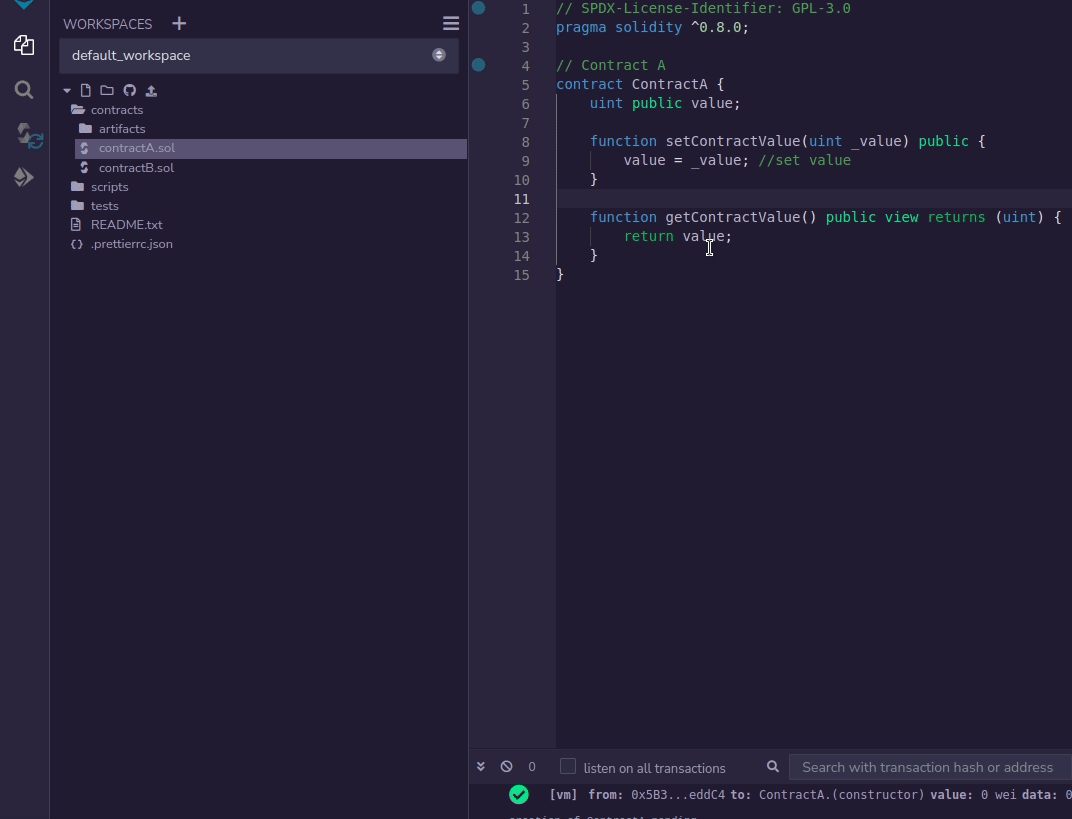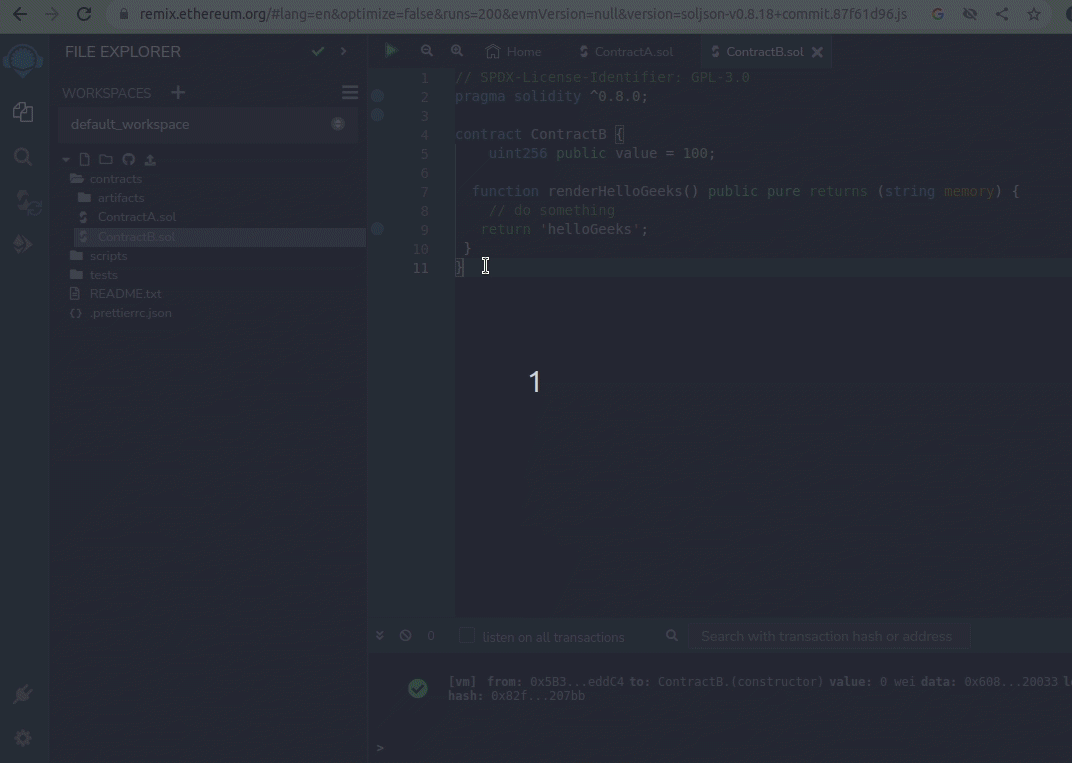Interaction Between Smart Contracts with Solidity
Last Updated :
01 Jun, 2023
Interaction between two smart contracts in Solidity means invoking functions of one contract from another contract so that we can use the content of one contract in another. For example, if you want to use contractA methods into contractB, so simply import the contractA inside contract B and create an instance of contractA then call methods using the dot operator.
Prerequisites
To interact with smart contracts written in Solidity, you will need the following software and tools:
- Remix IDE: The simplest way to compile, deploy and execute your solidity smart contract. Remix is an online IDE that allows you to write, test, and deploy Solidity contracts. It has a built-in Solidity compiler, so you don’t need to install one separately.
- Solidity Compiler: This is a software program that compiles Solidity code into bytecode that can be deployed on the Ethereum network.
- Ethereum: Ethereum is a network that allows you to interact with smart contracts.
- Web3.js Library: Web3.js is a JavaScript library that allows you to interact with smart contracts on the Ethereum network using some frontend language like React.js, angular.js or any other javascript framework. Basically, it is used as an interface between the front end and the back end.
- Metamask: Metamask is a browser extension(also available in the mobile app) that allows you to connect to the Ethereum network and interact with smart contracts using a browser-based interface. It provides a secure way to manage your Ethereum accounts and sign transactions.
- Truffle Framework: Truffle is a development framework that provides a suite of tools for building, testing, and deploying smart contracts on the Ethereum network. It includes a Solidity compiler, a testing framework, and a deployment tool.
- Ganache: Ganache is a personal blockchain for Ethereum development that allows you to test your smart contracts in a local environment. It provides a set of pre-configured accounts with fake Ether, so you can test your contracts without spending real Ether.
Approach
Step 1: Create a file contractA.sol
pragma solidity ^0.8.0;
contract contractA {
// … Write Code Here
}
Step 2: Create another file contractB.sol and import contractA using the import statement.
pragma solidity ^0.8.0;
import “./contractA.sol”;
contract contractB {
// … Write Code Here
}
Step 3: Deploy both contracts on the blockchain. Each contract will have its own address that can be used to interact with it.
pragma solidity ^0.8.0;
contract MyContractA {
// …
}
AND
pragma solidity ^0.8.0;
contract MyContractB {
// …
}
Step 4: In the contract(MyContractB) where you want to invoke the other contract’s function, you need to import the other contract. This can be done using the import keyword.
pragma solidity ^0.8.0;
import “./MyContractA.sol”;
contract MyContractB {
// …
}
Step 5: Create an instance of the other contract(MyContractA). In the same contract where you imported the other contract, you need to create an instance of it.
pragma solidity ^0.8.0;
import “./MyContractA.sol”;
contract MyContractB {
MyContractA myContractA = MyContractA(0x123456789…); // Replace with the actual address of the other contract
}
Step 6: Call the other contract’s function: Once you have created an instance of the other contract, you can call its functions using the instance. To do this, you need to know the function’s name and arguments. For example:
pragma solidity ^0.8.0;
import “./MyContractA.sol”;
contract MyContractB {
// Replace with the actual address of the other contract
MyContractA myContractA = MyContractA(0x123456789…);
function doSomething() public {
myContractA.anyFunction(args);
}
}
In the above example, anyFunction is a function in the MyContractA contract, which takes args. You can replace these with the actual values you want to pass to the function.
Method 1
Below we have two separate contracts contractA and contractB, to use one contract into another we should import one Solidity contract into another one, you can use the import keyword. Here’s an example of how we can do it.
Suppose we have two contracts, ContractA and ContractB and you want to import ContractA.sol into ContractB.sol. Here, Remix IDE is being used for contract compilation and deployment you can use any IDE that you wish, and create a new file named ContractA.sol.
Contract A:
Solidity
pragma solidity ^0.8.0;
contract ContractA {
uint public value;
function setContractValue(uint _value) public {
value = _value;
}
function getContractValue() public view returns (uint) {
return value;
}
}
|
In ContractB.sol, add the following import statement at the top after declaring the solidity version.
import "./ContractA.sol";
This tells Solidity to import ContractA.sol from the current directory and make its contents available in ContractB.sol.
Now we can use ContractA inside ContractB. For that, you can create an instance of ContractA and call its functions.
Contract B:
Solidity
pragma solidity ^0.8.0;
import "./contractA.sol";
contract ContractB {
address public contractAddress;
function setContractAAddress(address _address) public {
contractAddress = _address;
}
function updateContractAValue(uint value) public {
require(contractAddress != address(0), "Contract A address is not set");
ContractA contractA = ContractA(contractAddress);
contractA.setContractValue(value);
}
function getContractAValue() public view returns (uint) {
require(contractAddress != address(0), "Contract A address is not set");
ContractA contractA = ContractA(contractAAddress);
return contractA.getContractValue();
}
}
|
Output:

interaction between contracts
Method 2
Let’s say we have two smart contracts, ContractA and ContractB. ContractA has a function that calls a function in ContractB, and ContractB has a state variable that ContractA wants to access. Below is the Solidity program to implement the above approach:
ContractA.sol
Solidity
pragma solidity ^0.8.0;
import "./ContractB.sol";
contract ContractA {
ContractB public contractB;
function setContractB(address _contractBAddress) public {
contractB = ContractB(_contractBAddress);
}
function callContractB() public view returns (string memory) {
return contractB.renderHelloGeeks();
}
function getContractBState() public view returns (uint256) {
return contractB.value;
}
}
|
ContractB.sol
Solidity
pragma solidity ^0.8.0;
contract ContractB {
uint256 public value = 100;
function renderHelloGeeks() public pure returns (string memory) {
return 'helloGeeks';
}
}
|
Output:

interaction between contracts
Share your thoughts in the comments
Please Login to comment...